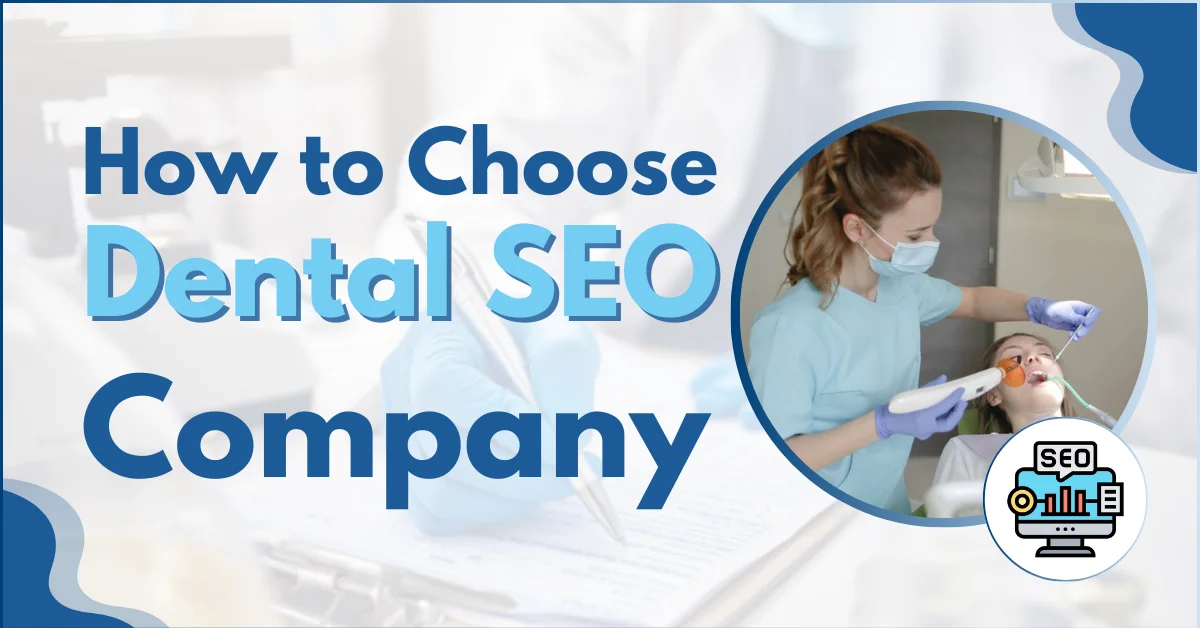If you are running a dental practice, you have probably been told that SEO (Search Engine Optimization) can help bring more patients through your door.
That is 100 percent true, but how do you actually know it’s working? Is it really worth the money you’re spending?
That’s what I have written this blog about: how to measure SEO ROI for your dental practice step by step, with examples that make sense. This guide will help you track real results from your investment if you work with a dental SEO expert, hire a dental SEO agency, or try handling SEO yourself.
What is SEO ROI for Dentists?
SEO ROI stands for “Return on Investment from SEO.” It tells you whether the money you’re spending on SEO is bringing in more money through new patients.
Here’s the simple formula:
SEO ROI = (Revenue from SEO – Cost of SEO) ÷ Cost of SEO × 100
In short, if you’re spending $1,000 on SEO and making $3,000 from new patients found through Google, you have a positive ROI, and that’s a win.
Why Should Dentists Measure SEO ROI?
You wouldn’t buy dental equipment without knowing if it helps your clinic, right? The same goes for SEO. Measuring ROI helps you:
SEO ROI Examples by Industry
Some industries see fast results; others, like healthcare, need time. For example:
SEO ROI in Healthcare & Dental Industry

In dentistry, one new patient can bring in thousands of rupees or dollars over time. Even if SEO brings you just 5–10 new patients a month, the long-term value adds up quickly.
That’s why tracking SEO ROI in dental care is so important, it shows the full picture.
How to Measure SEO ROI for Your Dental Practice: Key Metrics
To measure ROI properly, you need to track more than just traffic. Here are the key metrics to understand.
1. Rankings of Your Dental Website
This tells you where your dental website shows up in Google search results. If someone searches for dental services in your area and your website appears in the top three, that’s a good sign. Higher rankings mean more clicks.
2. Website Traffic of Your Dental Practice
Traffic shows how many people visit your website. But not all traffic is valuable. You want local, high-intent visitors, people who are actually looking for a dentist in your area.
Getting 2,000 random visitors is nice, but if none of them are local or looking for dental care, it doesn’t help. You want high-intent traffic, like people searching for:
These searchers are more likely to book.
3. Conversions
This is where things really matter. A conversion is when someone takes action on your site, such as:
These are the people most likely to become actual patients.
For example:
Dental websites typically have a 2–5% conversion rate from organic (SEO) traffic.
4. First Visit Spend (FVS) of Your Dental Patients
This is the average amount you earn from a patient’s first visit. For example, $100–$300 for an exam, X-rays, or cleaning.
5. Lifetime Value (LTV) of Your Patients
This is how much a patient brings to your practice over time. If someone stays for 3–5 years and gets regular cleanings, fillings, and maybe even cosmetic work, their LTV might be $2,000 to $10,000 or more.
6. Conversion Rate
This is the percentage of visitors who become leads or patients.
How to Measure SEO ROI for Your Dental Practice Step-by-Step

Let’s walk through how to actually calculate your dental SEO ROI.
Is your website helping you get more patients?
If the answer isn’t clear yet, now you know how to find out. Let us help you increase your SEO ROI

Step 1: Know the Formula for SEO ROI for Dentists
Just to repeat, here’s the formula again:
(Revenue from SEO – SEO Costs) ÷ SEO Costs × 100
This gives you a percentage that shows how profitable your SEO investment is.
Step 2: Calculate Your Costs
Add up everything you spend on SEO each month:
Example: You spend $1,000/month on SEO.
Step 3: Track Conversions
Use Google Analytics, CallRail, or similar tools to track:
Also, note how many of these conversions become paying patients.
Step 4: Estimate Revenue from Dental SEO
Let’s say:
Your monthly revenue = 5 × $300 = $1,500
Step 5: Use the ROI Formula
Now plug the numbers into the formula:
($1,500 – $1,000) ÷ $1,000 × 100 = 50% ROI
That’s a 50% return on your investment. If you track lifetime value, your ROI could be much higher.
You can use tools like SEO ROI calculators to do this task.
Calculation of Potential Revenue from SEO Example
Let’s do the math with a sample dental practice.
Monthly Revenue:
If your SEO costs $1,200/month, your ROI is:
FVS ROI: ($1,800 – $1,200) ÷ $1,200 × 100 = 50%
LTV ROI: ($18,000 – $1,200) ÷ $1,200 × 100 = 1,400%
Big difference, right?
That’s why tracking both short-term and long-term value matters.
How to Use Google Analytics and Tools to Track ROI?
Google Analytics Conversion Tracking
Google Analytics (GA4) helps you see where your visitors come from and what actions they take. Set up:
Assign Value to Conversion
Even if you don’t know the exact number, you can estimate:
Multiply the total number of conversions by the average value to get estimated revenue.
Filter SEO Traffic of Your Dental Website
To measure only organic SEO results, go to:
Use Tools to Calculate SEO ROI for Dental Practice
You can use online tools like:
Curious About Your SEO ROI?
Use our free Google Sheets templates or request your FREE PDF: “How to Measure SEO ROI for Dental Practices online”, and start tracking what really works.

These tools make the math simple and save time.
Month-by-Month Tracking Example
It’s normal to see a slow start. SEO is a long game.
| Month | New Patients from SEO | Revenue (FVS) | ROI (Est.) |
| 1 | 2 | $600 | -40% |
| 3 | 5 | $1,500 | +50% |
| 6 | 10 | $3,000 | +200% |
| 8 | 18 | $5,400 | +440% |
Keep tracking each month. ROI typically grows over time.
Winning Strategies to Increase SEO ROI for Your Dental Practice

We have discussed how to measure SEO ROI for your dental practice, but how can you improve ROI? Here are the strategies
1. Keep Your Dental Website Mobile-Friendly
A mobile-friendly website is an important part of dental technical SEO. If your site is slow, hard to use on a phone, or looks messy, Google may not show it high in search results.
Also, people might leave without booking. To keep both Google and your visitors happy, your website should load fast, look good on all screen sizes, and be easy to use.
2. Target Long-Tail Dental Keywords
Do the keyword research and find out relevant dental keywords for your website, and incorporate those keywords in your content naturally. Do not do stuffing, use it wisely.
These keywords attract people ready to book.
3. Optimize Your Google Business Profile
Update your address, hours, services, and add photos. Encourage happy patients to leave reviews. This helps Local SEO for dentists.
4. Create Helpful, Searchable Dental Content
Write dental blog posts answering common patient questions like:
Then, optimize these posts using basic SEO tips or hire a dental SEO expert.
5. Re-Optimize Old Dental Content
Go back to older service pages or blogs and update them with better keywords, FAQs, images, and internal links. Google rewards fresh content.
6. Understand the Patient Journey
Patients may visit your site 2–3 times before booking. Use free SEO tools to monitor multi-visit behavior and stay top of mind.
Common Challenges in Measuring SEO ROI for Dental Practice
Measuring too soon, SEO often takes 3–6 months to show real results
FAQs: How to Measure SEO ROI for a Dental Practice
Leave It to the Experts
If this still feels like too much to juggle while running your practice, you’re not alone. That’s why many clinics hire a dental SEO agency or a trusted dental SEO expert to handle the strategy and reporting for them.
They will help you get found online, bring in high-intent patients, and show you the numbers behind your investment.
Leave SEO to the Experts
Running a practice is hard enough; let us handle your dental SEO strategy, reporting, and growth. We help you attract high-intent patients and track ROI with clarity.

Final Thought
How to measure SEO ROI for a dental practice might sound a bit technical, but it’s really just about answering one simple question:
“Is the money and effort you’re spending on SEO actually helping you get more patients and grow your practice?”
That’s it. If your website is showing up when people search for a dentist near them, and some of those people call you or book an appointment, that means your SEO is working. Measuring ROI just helps you see how well it’s working, in clear numbers.







